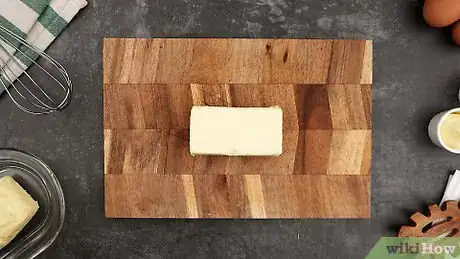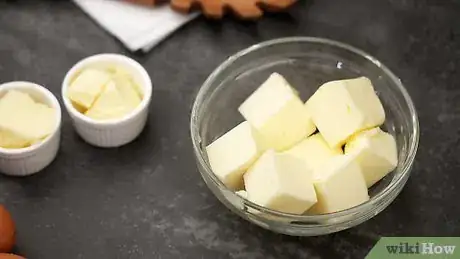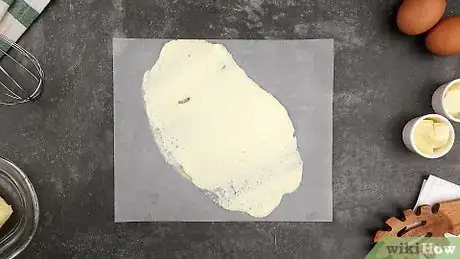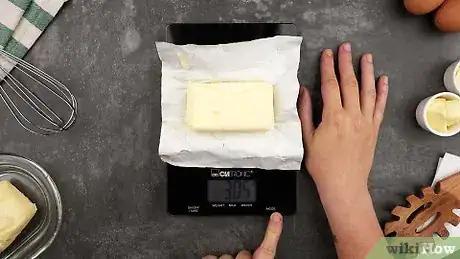This article was co-authored by Sarena Nelson and by wikiHow staff writer, Hunter Rising. Sarena Nelson is a Private Chef and the Founder of Chef Sarena, based in Palm Springs, California. With over 10 years of experience, she specializes in customized menus for private events, has worked in 5-star restaurants, and has helped small restaurants redesign their menus. She earned her degree from Le Cordon Bleu School of Culinary Arts in Pasadena, California.
This article has been viewed 178,853 times.
Butter is a key ingredient in many recipes and is crucial for creating delicious baked goods. Many recipes call for softened butter, but you may have forgotten to leave a stick out at room temperature. If you need to soften butter quickly, there are many ways to do it. Just be careful not to heat the butter too much or else it will melt!
Steps
Chopping Butter into Smaller Pieces
-
1Measure the amount of butter you need. Cut and measure your butter before you soften it since the stick could deform. Consult the recipe you’re using to see how much butter you need before using a measuring spoon or kitchen scale to get the exact amount you need.[1]
- If the butter is still in its wrapper, you may be able to see the measurements printed on the side so you can accurately cut it.
-
2Cut the butter into 1 in (2.5 cm) cubes. Use a sharp knife to cut the measured butter into small chunks. Make sure the chunks are about the same size so they all soften evenly. Separate the cubes from one another so they don’t stick together since that could slow down how fast they soften.[2]
- The increased surface area of the butter will allow it to soften faster.
Advertisement -
3Leave the butter at room temperature for 10-20 minutes. Set the chunks of butter on a plate and cover them with a tray or aluminum foil so nothing can get into the butter. Keep the butter in a place out of direct sunlight so it doesn’t melt. Leave the butter for about 20 minutes so it’s soft and easily spreadable.[3]
Tip: You can keep a whole stick of butter out at room temperature if you don’t want to worry about running out of softened butter when you need it.
Rolling the Butter
-
1Place the butter between 2 sheets of wax paper. Lay out a piece of wax paper on a flat countertop and set the amount of butter you need in the middle of the sheet. Put another layer of wax paper on top of the butter and press it down firmly so it stays in place. Make sure the wax paper pieces are the same size so the butter doesn’t squeeze out the side.[4]
- You may choose to cut the butter into cubes beforehand if you want.
-
2Hit the butter with a rolling pin 3-4 times to pound it down. Keep the wax paper in place with your non-dominant hand and hold a rolling pin by one of the handles with your other hand. Hit the butter firmly with your rolling pin 3-4 times to start the flattening process. Hit the butter until it’s a uniform thickness throughout.[5]
Warning: Only hit butter if you pulled it directly out of the fridge or freezer since butter that’s already soft may splatter out the sides of the paper.
-
3Roll the butter flat with the rolling pin. Once the butter is slightly flattened after hitting it, hold your rolling pin with both hands and spread it out like you would with dough. Aim to get the butter between 1⁄8–1⁄4 in (0.32–0.64 cm) thick to maximize the surface area. When you’re finished, peel off the top layer of wax paper.[6]
-
4Leave the butter at room temperature for about 5 minutes. The butter should feel relatively soft after you roll it out, but leave it on your counter for another 5 minutes. Once the butter is completely soft, peel it off of the wax paper and mix it in with the rest of your ingredients.[7]
- Softened butter could possibly stick to the wax paper. If you need to, scrape the butter with a knife to get it off completely.
Grating the Butter
-
1Measure the amount of butter you need for your recipe. Look at the side of the butter’s wrapper to see the measurements. Use a knife to cut the amount of butter you need for your recipe. If the butter is out of the wrapper, use measuring spoons or a kitchen scale to find the amount that you need.[8]
-
2Grate the butter into a bowl. Use the side of a box grater that has the largest holes so the butter pieces are the right size and shape for baking. Hold the grater and butter over a clean bowl so the pieces can fall in easily. Press the butter into the side of the grater with a firm amount of pressure to grate it into the bowl. Continue grating the butter until all of the pieces are in the bowl.[9]
- Only move the butter up and down rather than moving the grater. This will make it easier for you to grate.
- Grating works best if the butter comes directly out of the fridge or freezer.
Tip: Hold the butter by a piece of its wrapper if you don’t want to get your fingers greasy.
-
3Let the butter pieces soften for 5 minutes before adding it to your recipe. Leave the butter pieces in the bowl and let them heat up to room temperature for about 5 minutes. This will ensure that they’re soft and mix well with any other ingredients you’re using.[10]
- Grated butter works best for making crumbles or shortbread since it mixes thoroughly with the other ingredients.
- You can grate the butter directly in the bowl with your other ingredients if you want.
Using a Double Boiler
-
1Heat 2 c (470 ml) of water in a pot. Put the water in a small pot and warm it up over medium heat. Keep heating the water until it starts steaming, and then reduce the temperature to low heat.[11]
- You don’t need to bring the water to a boil or else it may get too hot.
-
2Set a glass or metal bowl on top of the pot. Put a heat-safe bowl over the pot to cover it. Make sure the bowl covers the opening on the pot entirely or else it may not heat up as well. Let the bowl heat up for 1-2 minutes so it’s warm to the touch.[12]
- If you have a special double boiler pot, you can use that as well.
-
3Put your butter into the bowl to soften it. Place the amount of butter you need for your recipe inside the bowl and watch it carefully. The steam from the pot will heat up the bowl and start to soften the butter. Test the softness of the butter with a spoon to see if it’s still hard or not. When the butter breaks apart easily with a spoon, take the bowl off the pot.[13]
- Be sure to remove the bowl before the butter starts to melt.
Warning: A metal or glass bowl will get hot, so use an oven mitt or pot holder when you need to touch it.
Heating the Butter in a Microwave
-
1Cut the butter into 1⁄2 inch (1.3 cm) squares. Measure out the amount of butter you need for your recipe and cut it off the stick with a chef’s knife. Then use your knife to cut the pieces into 1⁄2 in (1.3 cm) chunks so it softens faster. Put all of the chunks in a microwave-safe container.[14]
- You don’t need to cut the butter, but it will make it soften faster in your microwave.
-
2Put the butter in your microwave for 5 seconds. Set the container of butter in the center of the microwave and turn it on for 5 seconds. Watch the butter as the microwave runs to make sure it doesn’t melt. After the microwave is finished, test the hardness of your butter with your finger or a spoon. See if the cubes feel solid in the center or if they’re soft.[15]
- In most microwaves, your butter won’t be fully softened after the first 5 seconds.
Tip: If you can change the intensity of your microwave, then set it to low to help prevent your butter from melting.
-
3Use 5 seconds increments until the butter is soft but not melted. If your butter still feels hard after the first time you microwave it, put it in for another 5 seconds. Be sure to watch the butter so it doesn’t start melting. When the butter feels soft throughout, take it out and incorporate it in your recipe.[16]
- Butter can melt quickly in a microwave, so be ready to stop the machine at a moment’s notice.
Expert Q&A
Did you know you can get premium answers for this article?
Unlock premium answers by supporting wikiHow
-
QuestionWhat is the best way to soften butter without a microwave?
 Sarena NelsonSarena Nelson is a Private Chef and the Founder of Chef Sarena, based in Palm Springs, California. With over 10 years of experience, she specializes in customized menus for private events, has worked in 5-star restaurants, and has helped small restaurants redesign their menus. She earned her degree from Le Cordon Bleu School of Culinary Arts in Pasadena, California.
Sarena NelsonSarena Nelson is a Private Chef and the Founder of Chef Sarena, based in Palm Springs, California. With over 10 years of experience, she specializes in customized menus for private events, has worked in 5-star restaurants, and has helped small restaurants redesign their menus. She earned her degree from Le Cordon Bleu School of Culinary Arts in Pasadena, California.
Private Chef There are lots of different ways! It always helps to have a butter dish out on the counter so you always have some soft butter on hand. You can also soften your butter on the stovetop, or stick it in a butter bell—this is a device that helps the butter stay fresh by keeping it at a certain temperature.
There are lots of different ways! It always helps to have a butter dish out on the counter so you always have some soft butter on hand. You can also soften your butter on the stovetop, or stick it in a butter bell—this is a device that helps the butter stay fresh by keeping it at a certain temperature. -
QuestionHow can I tell when butter is softened enough for baking with?
 wikiHow Staff EditorThis answer was written by one of our trained team of researchers who validated it for accuracy and comprehensiveness.
wikiHow Staff EditorThis answer was written by one of our trained team of researchers who validated it for accuracy and comprehensiveness.
Staff Answer wikiHow Staff EditorStaff AnswerCheck the wrapper; properly softened butter will leave a residue of fat on the wrapping (cold butter won't do this). Press the butter with your finger––properly softened butter will form a small dent but still keeps the shape of the stick. Or, try bending the butter gently; softened butter will have a little give, unlike cold butter; it shouldn't break or crack––if it does, it is too softened and needs to be refrigerated a little again. Butter that is still too cold or that is softened too much will cause the baked goods to be either too hard (cold butter) or too dense (overly soft butter). Aim for cool room temperature softened butter.
wikiHow Staff EditorStaff AnswerCheck the wrapper; properly softened butter will leave a residue of fat on the wrapping (cold butter won't do this). Press the butter with your finger––properly softened butter will form a small dent but still keeps the shape of the stick. Or, try bending the butter gently; softened butter will have a little give, unlike cold butter; it shouldn't break or crack––if it does, it is too softened and needs to be refrigerated a little again. Butter that is still too cold or that is softened too much will cause the baked goods to be either too hard (cold butter) or too dense (overly soft butter). Aim for cool room temperature softened butter. -
QuestionHow long does it take to soften butter?
 wikiHow Staff EditorThis answer was written by one of our trained team of researchers who validated it for accuracy and comprehensiveness.
wikiHow Staff EditorThis answer was written by one of our trained team of researchers who validated it for accuracy and comprehensiveness.
Staff Answer wikiHow Staff EditorStaff Answer
wikiHow Staff EditorStaff Answer
Warnings
- Do not allow butter to melt when softening since it may negatively impact your baking.⧼thumbs_response⧽
Things You’ll Need
Chopping Butter into Smaller Pieces
- Cutting board
- Chef’s knife
- Plate
Rolling the Butter
- Knife
- Wax paper
- Rolling pin
Grating the Butter
- Box grater
- Bowl
Using a Double Boiler
- Pot
- Glass or metal bowl
- Oven mitt
Heating the Butter in a Microwave
- Chef’s knife
- Microwave-safe bowl
- Microwave
Expert Interview
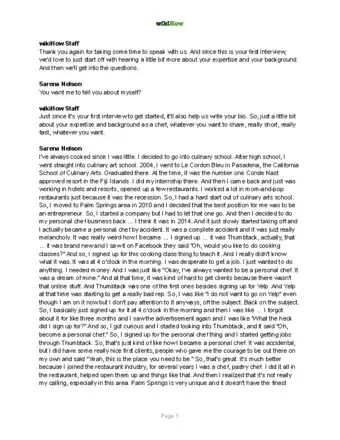
Thanks for reading our article! If you'd like to learn more about softening butter, check out our in-depth interview with Sarena Nelson.
References
- ↑ https://www.mybakingaddiction.com/how-to-soften-butter/
- ↑ https://www.mybakingaddiction.com/how-to-soften-butter/
- ↑ https://www.mybakingaddiction.com/how-to-soften-butter/
- ↑ https://www.simplyrecipes.com/recipes/tip_how_to_soften_butter_quickly/
- ↑ https://www.simplyrecipes.com/recipes/tip_how_to_soften_butter_quickly/
- ↑ https://www.simplyrecipes.com/recipes/tip_how_to_soften_butter_quickly/
- ↑ https://www.simplyrecipes.com/recipes/tip_how_to_soften_butter_quickly/
- ↑ https://www.thekitchn.com/why-you-should-grate-the-butter-next-time-you-bake-tips-from-the-kitchn-208507
- ↑ https://www.thekitchn.com/why-you-should-grate-the-butter-next-time-you-bake-tips-from-the-kitchn-208507
- ↑ https://www.thekitchn.com/why-you-should-grate-the-butter-next-time-you-bake-tips-from-the-kitchn-208507
- ↑ https://www.thekitchn.com/3-ways-to-soften-butter-quickly-and-easily-54814
- ↑ https://www.thekitchn.com/3-ways-to-soften-butter-quickly-and-easily-54814
- ↑ https://www.thekitchn.com/3-ways-to-soften-butter-quickly-and-easily-54814
- ↑ https://www.mybakingaddiction.com/how-to-soften-butter/
- ↑ https://www.mybakingaddiction.com/how-to-soften-butter/
- ↑ https://www.mybakingaddiction.com/how-to-soften-butter/
About This Article
To soften butter quickly, heat it in the microwave for 5-second intervals until it's soft enough. You can also cut the butter up into small pieces before leaving it out to soften, which will help it soften faster. If you're in a rush but you don't have a microwave, put the butter in a sealable plastic bag and then flatten it with a rolling pin until it's about 1/4 inch thick. Once you're done flattening the butter, it should be softened! For more tips, including how to heat the butter on a stovetop if you don't have a microwave, read on!
